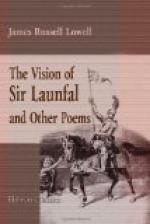“Have ye founded your
throne and altars, then,
On the bodies and souls of
living men?
And think ye that building
shall endure,
Which shelters the noble and
crushes the poor?”
These early poems and passages in others written at about the same time, taken in connection with the Vision, show how strongly the theme had seized upon Lowell’s mind.
The structure of the poem is complicated and sometimes confusing. At the outset the student must notice that there is a story within a story. The action of the major story covers only a single night, and the hero of this story is the real Sir Launfal, who in his sleep dreams the minor story, the Vision. The action of this story covers the lifetime of the hero, the imaginary Sir Launfal, from early manhood to old age, and includes his wanderings in distant lands. The poem is constructed on the principles of contrast and parallelism. By holding to this method of structure throughout Lowell sacrificed the important artistic element of unity, especially in breaking the narrative with the Prelude to the second part. The first Prelude describing the beauty and inspiring joy of spring, typifying the buoyant youth and aspiring soul of Sir Launfal, corresponds to the second Prelude, describing the bleakness and desolation of winter, typifying the old age and desolated life of the hero. But beneath the surface of this wintry age there is a new soul of summer beauty, the warm love of suffering humanity, just as beneath the surface of the frozen brook there is an ice-palace of summer beauty. In Part First the gloomy castle with its joyless interior stands as the only cold and forbidding thing in the landscape, “like an outpost of winter;” so in Part Second the same castle with Christmas joys within is the only bright and gladsome object in the landscape. In Part First the castle gates never “might opened be”; in Part Second the “castle gates stand open now.” And thus the student may find various details contrasted and paralleled. The symbolic meaning must be kept constantly in mind, or it will escape unobserved; for example, the cost of earthly things in comparison with the generosity of June corresponds to the churlish castle opposed to the inviting warmth of summer; and each symbolizes the proud, selfish, misguided heart of Sir Launfal in youth, in comparison with the humility and large Christian charity in old age. The student should search for these symbolic hints, passages in which “more is meant than meets the ear,” but if he does not find all that the poet may or may not have intended in his dreamy design, there need be no detraction from the enjoyment of the poem.




